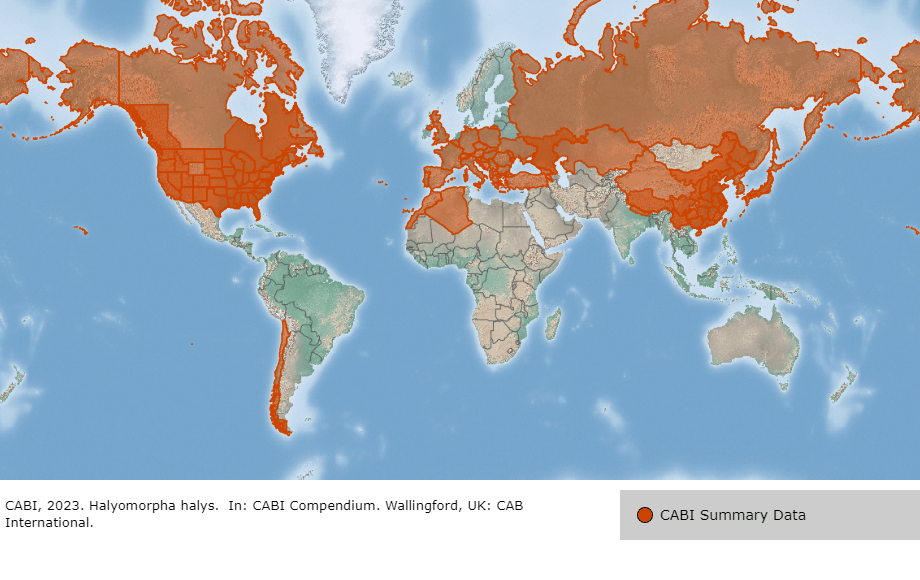 Brown marmorated stink bug Brown marmorated stink bug |
Status LU: established. 1st record: 2022, ITW 2022. | |
 Brong marbréiert Bamwanz Brong marbréiert Bamwanz |
Status Eur.: established. 1st record: 1998 | |
 Punaise diabolique Punaise diabolique |
RA: ISEIA: n/a Harmonia+: n/a | |
 Marmorierte Baumwanze Marmorierte Baumwanze |
Wikipedia: |
|
 Bruin gemarmerde schildwants Bruin gemarmerde schildwants |
Back to the list of neozoa |
Contents
Report the species
→ Report Halyomorpha halys to the National Museum of Natural History.
Brief description
The brown marmorated stink bug (Halyomorpha halys) is native to China, Japan, Korea and other Asian regions. In 1998 it was collected in Pennsylvania/USA, where it is believed to have been accidentally introduced. The nymphs and adults of the brown marmorated stink bug feed on over 100 species of plants, including many agricultural crops, and by 2010 had become a season-long pest in orchards in the Eastern United States. The brown marmorated stink bug was probably first introduced to Europe during the repair work of the Chinese Garden in Zurich, Switzerland in the winter of 1998. The stink bug has been traced back to have travelled with roof tiles that were imported from Beijing, China. The first sighting in southern Germany was made in Konstanz in 2011. In Italy the first specimens were found in Modena in 2012 and afterwards in South Tyrol in 2016. The pest rapidly spread across Europe, and it is currently present in nearly every European country as well as in many parts of North and South America. The rapid spread of the species is linked to its ability to hitchhike, particularly in autumn when it seeks shelter in any man-made structure to overwinter, and easily travels with us and our means of transportation. H. halys has also a strong capacity to disperse at landscape levels throughout most periods of its lifetime. The species has over 100 reported host plants. It is widely considered to be an arboreal species and can frequently be found among woodlots. In orchards where H. halys is established in the USA, it is a season-long pest of tree fruit. In particular, peaches, nectarines, apples and Asian pears are heavily attacked. The brown marmorated stink bug is likely to invade homes in the fall. The bug survives the winter as an adult by entering houses and structures when autumn evenings become colder, often in the thousands. In one home, more than 26,000 stinkbugs were found overwintering. Once inside the house, they go into a state of hibernation (CABI 2013, Wikipedia contributors 2023).
Status and distribution in Luxembourg
Records of Halyomorpha halys (Stål, 1855) in Luxembourg. Data source: Recorder-Lux, iNaturalist & GBIF, 2024-07-27.
There are only a few observations of the species documented for Luxembourg so far, the first one from September 2022 in Frisingen.
Risk assessment
ISEIA protocol
Not assessed yet.
Harmonia+ protocol
Not assessed yet.
Worldwide distribution

Bibliography
- CABI, 2013. ‘Halyomorpha halys’ (2013) CABI Compendium.doi.org: 10.1079/cabicompendium.27377. [accessed 2023-11-14]
- MNHNL, iNaturalist & GBIF, 2023. Halyomorpha halys (Stål, 1855) in MNHNL-mdata, online portal combining species observation from Recorder-Lux, iNaturalist and GBIF. National Museum of Natural History, Luxembourg. URL: https://mdata.mnhn.lu [Accessed 2023-11-14]
- Wikipedia contributors, 2023. ‘Brown marmorated stink bug’, Wikipedia, The Free Encyclopedia, 6 November 2023, 19:56 UTC, <https://en.wikipedia.org/wiki/Brown_marmorated_stink_bug> [accessed 2023-11-14]
Suggested citation of this webpage
Ries, C. & M. Pfeiffenschneider (Eds.), 2024. Halyomorpha halys (Stål, 1855). In: neobiota.lu - Invasive Alien Species in Luxembourg. National Museum of Natural History, Luxembourg. URL: https://neobiota.lu/halyomorpha-halys-stal-1855-2/ [Accessed 2024-07-27].
Page content last updated on 2023-12-14. Last proofread by Caroline Grounds on 2023-10-26.

